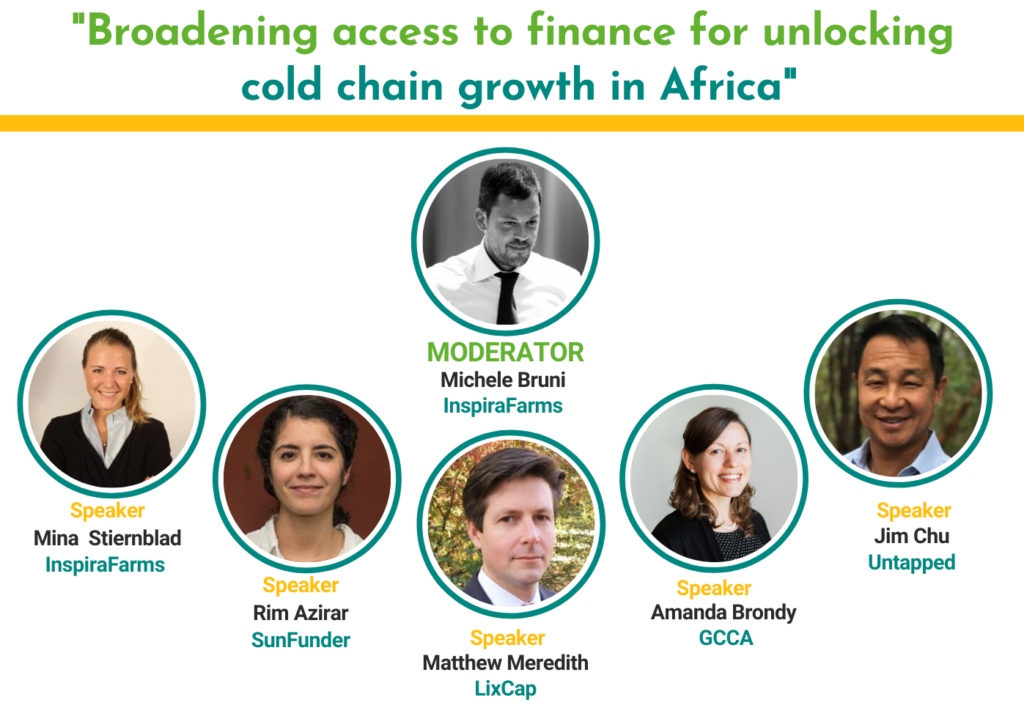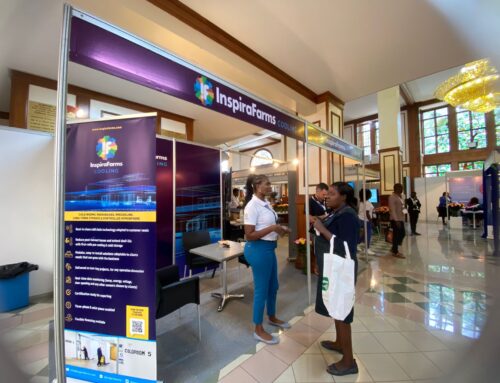Webinar key takeaways: Broadening access to finance for unlocking cold chain growth in Africa
Our webinar “broadening access to finance for unlocking cold chain growth in Africa,” brought together speakers in the industry, Senior Director of the Global Cold Chain Alliance Amanda Brondy , Senior Investment Officer at SunFunder, Rim Azirar, Executive Managing Director and Co-founder of Ifria Matthew Meredith, Founder and Chief Executive Officer of Untapped, Jim Chu and lastly, Chief Finance Officer at InspiraFarms, Mina Stiernblad.
The webinar was led and moderated by Chief Commercial Officer, Michele Bruni also, from InspiraFarms.

They brought to light the challenges and the importance of investing and financing cold chain solutions for agribusinesses, especially those in the first mile of distribution of fresh produce supply chains. As well was highlighted alternatives and opportunities for increasing, improving, and innovating the financial agricultural cold chain sector in the following key points:
1. Challenges in cold chain development and investment
The cold chain supply chain encompasses various actors for a successful harvest. It brings together farmers, small holder farmer, processors, exporters, importers etc. The type of investment differs depending on who you are working with and it is critical to know what is right for each type of donor.
Amanda Brondy started off the panelists speaking on the challenges in cold chain development and investment on donor development financing. She emphasized on proving the need of a cold chain as compared the actual demand that exists.
She stated that, “when we look at cold chain investments, we are often looking at it in a private sector lens meaning, we want to be sustainable whether the business can continue on. This will not happen if there is no market to buy. If the consumer cannot buy, then the business is not sustainable.”
One of her stated challenges was on the lack of coordination between different donors. She confirmed that there has been a strong increase in the cold chain donor community and together, they bring different ideas to grow the sector in terms of building businesses, conducting trainings, and developing infrastructure.
“The more collaborative effort goes into openly sharing different aspects, the more we can do to build more integrated cold chain developments in Africa,” she said.
Lastly, a lack of funding going into getting innovations to the next level in the sector was considered to be a setback for cold chain developments.
“It takes a long time for people to uptake technologies. This is a persistent and ongoing challenge that does not disappear overnight. It’s not just about innovating but working with those businesses to help get their information across and is a sustained effort that takes a lot of time,” Amanda concluded.
2. Financing of cold chain developments.
Andrew gave more insight on what they look for when financing cold chain developments which were:
- The range of tools and stakeholders involved to provide access to finance to support cold chain assets.
- The technical aid coming from various sources to ensure sustainable quality and quantity of a product.
- The market system access and the willingness to pay to offset various needed costs in the supply chain.
- Sustainable qualities and quantities that justify your investment throughout the year.
- The credit worthiness of a company interested in investing in a cold chain.
Andrew concluded by saying that, “it is crucial to look long at the market system starting at the producer and input supply side to comprehensively provide a financing structure in place. This ensures that the ecosystem using that asset is capable of providing products that are of quality and quantity while enabling systemic access to the markets, justifying the throughput through those assets and cold chain linkages.”
3. Gaps and opportunities for asset finance of cold chain developments
Productivity of an agricultural product or the productivity of an agricultural farm in Africa is a large topic. Rim narrowed down the challenges so far in financial innovation within cold chain developments that were scaling, standardization and long-term sustainability.
As lenders, Rim stated that it is important not to overburden borrowers by providing financial tools that do not suit their needs.
“We are seeing this segment of market and the need of financing grow that will bring a lot of efficiency in the way that we provide our loans,” she said.
The standardisation of products in the cold chain can also be difficult however possible. The process and requirements for different produce requires different measurements in cooling and packing. A vast majority of time should go into the technicality and the fine tuning of every single unit or asset. Therefore, Rim said that there is a financing need that has to be tagged to those specific cash flows from the specific farm.
Rim concluded by reiterating Amanda’s sentiments on long term sustainability saying that, “all this takes time to bare fruits and for the end users to understand the benefits overall for donors and lenders. It also takes time for the community to see that this is something that could have a massive impact on the continent.”
4. Success factors to consider scaling up cold chain finances in Africa.
With the certification of cold chain developments, customers have experienced tangible positive effects as stated by Mina during the webinar. Here she mentioned three success factors on how asset finance has unlocked opportunities for agribusinesses.
Firstly, reduced rejection is seen to be a significant success factor from customers, be it in the export or local markets that add up the monetary value of their business.
She also confirmed that cold chain facilities helped in the reduction of Post-Harvest Losses (PHL) saying that instead of driving to the closest cold storage, on-farm cold storage has reduced the PHL in the first mile which have caused positive financial effects for agribusinesses and small holder farmers.
Lastly, agribusinesses and farmers invest in cold chain solutions to increase the volume of their produce. These factors enable the agribusiness, in many cases, to pay for the cold storage units under finance.
In addition, she stated that the financing that InspiraFarms currently have, thanks to SunFunder, is the 5-year financing facility where they can finance 80% of the invoice value with flexible repayments scheduled to match the harvest.
“Agribusinesses have a strain of the cash flows due to seasonality and therefore, InspiraFarms does not request any additional collateral. It’s really about creating an investment in a productive asset that will pay for itself overtime,” she concluded.
5. Asset finance innovations in cold chain developments
There is not a great deal of innovation around financing according to Jim however, he sees an opportunity in finding new ways of providing financing through digital payments and assets that are controlled and managed from IoT and other remote management tools.
This changes the picture on how lending institutions or how investors can look at an asset and potentially provide financing for that asset.
He went on to say that, “typical project financing can take a lot of time and money for the legal process to come through. That means that only large-scale loans or financing is possible. With the innovation in digitization, we have seen a shift on how that could be done.”
He emphasized on shortening the time of analysis used in lending to people at scale that do not have the typical collateral or balance sheets.
Other factors were that, through digital lending, one could significantly reduce the administrative costs of providing financing while reducing long term burden and default risk. This therefore, will provide access to more borrowers instead of focusing simply on larger institutions or companies.
Need more insight? Find the full webinar on “broadening access to finance for unlocking cold chain growth in Africa,” below:



